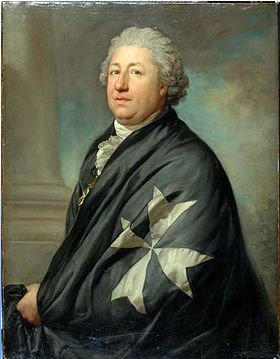Wilhelm Heinrich von Lepel

Wilhelm Heinrich Ferdinand Karl Graf von Lepel (* May 2, 1755 in Nassenheide ; † January 20, 1826 in Herrnhut , Upper Lusatia) was the royal Prussian envoy to the Swedish court in Stockholm, heir and feudal lord to Böck, Nassenheide, Plöwen, Blankensee, Frauenhagen and cow pasture, art collector and knight of the Order of St. John and the Red Eagle .
family
Wilhelm von Lepel was the son of Friedrich Wilhelm von Lepel , manorial estate owner on Boeck , Blankensee and Nassenheide , and Countess Amalie Henckel von Donnersmarck (1720–1783).
He remained unmarried and childless.
Life
In 1768 Wilhelm came to the Royal Knight Academy in Liegnitz in Silesia at the age of 13 . In 1770 Wilhelm left this to study law and natural sciences at the universities of Frankfurt / Oder , Halle and Leipzig . After completing his studies, he stayed for several years in Rheinsberg Castle near Neuruppin at the bachelor's yard of Prince Heinrich of Prussia . After the Rheinsberg years, Wilhelm held a similar position in Friedrichsfelde Palace near Berlin at the court of the Lord Master of the Order of St. John, Prince Ferdinand of Prussia , the youngest brother of King Friedrich and Prince Heinrich. In 1785 Wilhelm was knight of the Order of St. John and designated commander of Schivelbein and in 1787 Royal Prussian Chamberlain.
From 1787 to 1790 he was Prussia's extraordinary envoy to the Swedish court in Stockholm. After the end of the ambassadorial time in the Swedish capital, he left the civil service to live in Nassenheide as a privateer. Now he was able to embark on a long trip to southern countries that had been planned for years. After two years of eventful educational trips, he returned to Pomerania in 1794 and then toured Western Europe.
In the summer of 1806 Wilhelm traveled to the Bohemian spa Karlsbad. There he met Johann Wolfgang von Goethe , who was also in Karlsbad from June 29 to August 8, 1806. This wrote in a letter:
A surprisingly pleasant appearance was a
portfolio of copperplate engravings that Count Lepel
carries with him and in which he keeps the acquisitions
that he makes along the way. The seven sacraments of
Poussin were almost entirely new to me, and
I also saw a good part of Rembrandt again with great
pleasure.
On his estate in the area of the former horse paddock, Wilhelm created a landscape park based on the English model. The casual, "natural" landscaped gardens were fashionable at the time.
His work as an important art collector, with which he continued his father's passion for collecting with even greater energy, earned him the appointment as an honorary member of the Academy of Arts.
In order to accommodate his extensive art collections appropriately, he had the Nassenheider manor house converted into a palace. From then on, the one-story south wing he added housed the numerous art objects and the count's library with works on ancient art. Wilhelm brought most of the art objects he had collected with him from Italy. This includes a lot of bronze statues, original antique pieces of marble, numerous plaster casts, including heads of Jupiter and Juno. He also made these collections available to the interested public.
Then, in an addendum to the will (Codizill) drawn up two years before his death, he donated his important collection of copperplate engravings from the hands of important Italian, English and French masters to the Prussian state. It was handed over to the Museum of the Royal Academy of the Arts and later (1833) left for safekeeping to the Kupferstichkabinett Berlin, which was set up in the academy building especially to hold Lepel's collections . In appreciation of this donation by will, King Friedrich Wilhelm III. to Wilhelm Heinrich Graf von Lepel the Order of the Red Eagle, second class.
In the spring of 1824, two years before his death, Herrnhut became Wilhelm's permanent residence in Upper Lusatia. There were health reasons that moved him to settle there permanently.
He died in the Moravian Inn, where he had moved into a room.
The legal feudal heirs were his widowed sisters Ottilie Countess Henckel von Donnersmarck and Ulrike von Schmeling.
literature
- Historisch-Genealogisches Handbuch des Familie v. Lepel (Lepell). Developed by Andreas Hansert and Oskar Matthias Frhr on the basis of family history sources. v. Lepel with the assistance of Klaus Bernhard Frhr. v. Lepel and Herbert Stoyan. German Family Archives, Volume 151, Verlag Degener & Co., owner Manfred Dreiss, Insingen 2008, ISBN 978-3-7686-5201-8 .
- Oskar Matthias Frhr. v. Lepel: Nassenheide in Pomerania. History of a manor. Barton Verlag, Metternich 2014, ISBN 978-3-934648-03-6 .
Web links
| personal data | |
|---|---|
| SURNAME | Lepel, Wilhelm Heinrich von |
| ALTERNATIVE NAMES | Lepel, Wilhelm Heinrich Ferdinand von |
| BRIEF DESCRIPTION | Manor owner |
| DATE OF BIRTH | May 2, 1755 |
| PLACE OF BIRTH | Nassenheide |
| DATE OF DEATH | January 20, 1826 |
| Place of death | Herrnhut , Upper Lusatia |
